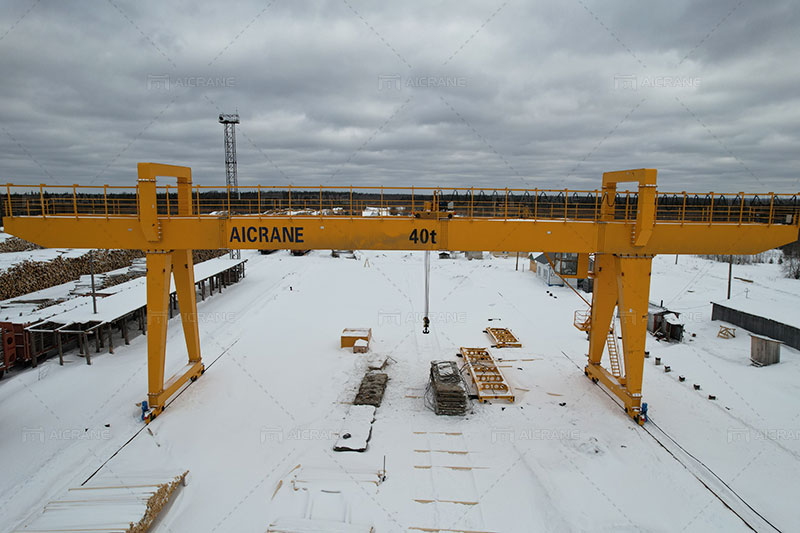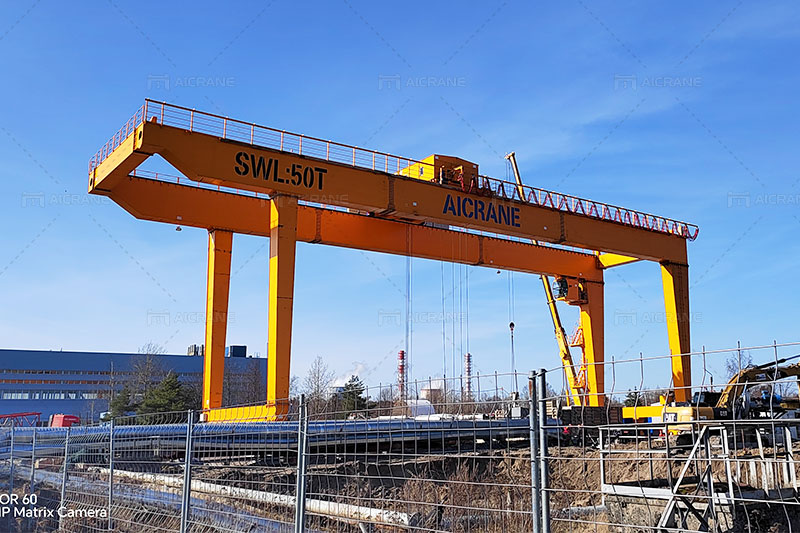Double girder gantry cranes are vital assets in various industrial settings, including shipyards, construction sites, and warehouses. Known for their robust lifting capabilities and versatility, these cranes can handle heavy loads with precision. However, ensuring their longevity and safety requires diligent maintenance and operational practices. In this article, we will discuss comprehensive strategies to extend the lifespan of your double girder gantry crane and ensure its safe operation.

1. Regular Maintenance and Inspections
Routine Inspections: Conducting regular inspections is crucial for identifying potential issues before they escalate. Schedule daily, weekly, and monthly checks of key components such as the hoist, trolley, brakes, and rails. Look for signs of wear and tear, such as frayed cables, loose connections, or unusual noises.
Lubrication: Proper lubrication of moving parts, including bearings, gears, and joints, reduces friction and wear. Use the manufacturer-recommended lubricants and adhere to the lubrication schedule outlined in the crane’s maintenance manual.
Cleaning: Keep this heavy duty cycle crane clean from dust, debris, and corrosive materials. Accumulated dirt can lead to mechanical problems and increase the risk of accidents. Regularly clean the crane’s exterior and inspect the interior for any signs of damage or malfunction.
2. Adhere to Load Capacity Limits
Avoid Overloading: One of the most common causes of crane failure is overloading. Always adhere to the crane’s specified load capacity. Operating beyond the crane’s rated capacity can cause significant stress on structural components, leading to premature wear or failure.
Load Distribution: Ensure that loads are evenly distributed across the crane’s girder. Uneven loads can cause imbalance, which may lead to structural damage or operational hazards. Use load indicators and limit switches to monitor and control load distribution.

3. Proper Operation and Training
Operator Training: Only trained and certified personnel should operate the crane. Proper training ensures that operators understand the crane’s controls, load capacities, and safety protocols. Regularly update training programs to reflect new safety standards and technological advancements.
Safe Operating Procedures: Establish and enforce standard operating procedures (SOPs) for overhead gantry crane operations. This includes guidelines for lifting, lowering, and maneuvering loads. Operators should also be aware of emergency procedures in case of equipment failure or other hazards.
Avoid Rapid Movements: Rapid or jerky movements can cause mechanical stress and reduce the crane’s lifespan. Operators should use smooth and gradual motions when lifting or moving loads to minimize wear on the crane’s components.
4. Implement Safety Measures
Safety Inspections: Conduct thorough safety inspections before each shift. Check for any signs of malfunction or wear that could pose a risk to operators or other personnel. Ensure that safety features such as limit switches, alarms, and emergency stops are functioning correctly.
Protective Equipment: Provide operators and maintenance personnel with appropriate personal protective equipment (PPE), such as helmets, gloves, and safety glasses. This helps prevent injuries in case of accidental drops or equipment failures.
Emergency Protocols: Develop and communicate clear emergency protocols for various scenarios, including equipment failure, accidents, or power outages. Ensure that all personnel are familiar with these procedures and conduct regular drills to reinforce their effectiveness.
5. Address Repairs Promptly
Immediate Repairs: Address any issues or malfunctions immediately to prevent further damage. Delaying repairs can lead to more severe problems and potentially compromise safety. Maintain a record of all repairs and replacements to track the crane’s condition over time.
Use Genuine Parts: When replacing parts, always use genuine components from the manufacturer. Non-original parts may not meet the required specifications and can negatively impact the crane’s performance and safety.
Professional Assistance: Engage qualified technicians for complex repairs or maintenance tasks. Professional expertise ensures that repairs are conducted correctly and that the Aicrane crane remains in optimal working condition.
6. Environmental Considerations
Protect Against Corrosion: In harsh environments, such as those with high humidity or exposure to chemicals, corrosion can be a significant issue. Apply protective coatings and regularly inspect for signs of rust or corrosion. Address any issues promptly to prevent structural damage.
Temperature Management: Extreme temperatures can affect the crane’s performance and components. Ensure that the crane operates within its designed temperature range. Implement measures to protect the crane from extreme cold or heat, such as using heaters or coolers if necessary.
7. Monitoring and Upgrades
Performance Monitoring: Utilize monitoring systems to track the crane’s performance and operational data. Advanced systems can provide insights into load patterns, operating hours, and component health. Use this data to predict maintenance needs and identify potential issues early.
Technological Upgrades: Stay updated with advancements in crane technology. Upgrading to newer control systems or safety features can enhance performance and safety. Consult with the manufacturer or a professional to determine the benefits of upgrading and to ensure compatibility with your existing crane.
8. Documentation and Records
Maintenance Logs: Keep detailed records of all maintenance activities, inspections, repairs, and upgrades. Maintenance logs help track the crane’s condition and provide valuable information for future troubleshooting or audits.
Compliance Records: Ensure that your crane meets all relevant safety standards and regulations. Maintain records of compliance inspections and certifications to demonstrate adherence to industry standards.
Conclusion
Extending the lifespan of your double girder gantry crane and ensuring its safety requires a comprehensive approach involving regular maintenance, proper operation, safety measures, prompt repairs, environmental considerations, and monitoring. By implementing these strategies, you can enhance the crane’s reliability, prevent costly downtime, and ensure a safe working environment for all personnel. Investing time and resources into maintaining your crane not only prolongs its service life but also contributes to a more efficient and safer operation.